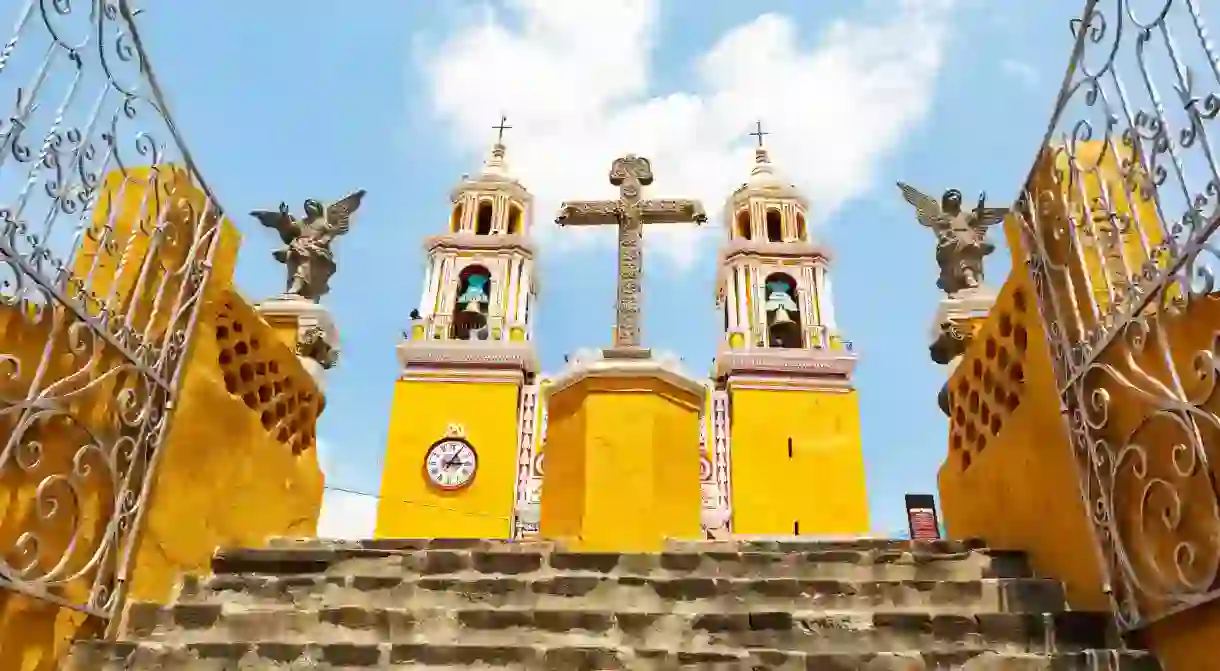Top Things to See and Do in Cholula, Mexico

The town of Cholula in central Mexico was an important economic and religious center long before the Spanish arrived to the Americas. Known for its Great Pyramid, hundreds of churches and close to Popocatépetl – Mexico’s second-highest mountain – Cholula has become a popular destination to visit. Here’s our round-up of the best things to see and do in town.
Hiking in Cerro Zapotecas
Natural Feature

These are amazing scenes: pine-scented woodlands, views over the plains to the distant twin peaks of smoking Popocatépetl and Iztaccíhuatl volcanoes and trails for mountain biking and hiking. The Cerro Zapotecas hills are a popular escape from urban Cholula. And since they’re only 3km (1.9mi) from Plaza de la Concordia, Cholula’s main square, they’re easy to reach by cab. Allow at least an hour to reach the summit on the steep path from the trailhead at the HCB Hotel in the Bosques de Tepoya condominium.
Ascending Popocatépetl
Natural Feature

There are no technical climbs and the views are jaw-dropping, but summiting Mexico’s second-highest peak is still a challenge. It’s an active volcano, spewing clouds of ash, and it rises to an altitude of 5,426m (17,930ft) – a full kilometer (3300 ft) taller than any mountain in the USA outside Alaska, with dangers of altitude sickness and freezing conditions. Paths are not clear so before setting out, take advice on safety and hire a local guide.
See the largest pyramid in the Americas
Archaeological site, Historical Landmark

Cholula’s Great Pyramid is what puts this small town outside of Puebla State’s capital on the map. Known as Tlachihualtepetl, its base is the widest in the Americas, but only one staircase on one side this pyramid has been excavated – due to the fact that the Spanish built a church right on top of it. You can visit the archaeological site that surrounds the pyramid though, with several other interesting structures, and even take a walk through the pyramid’s tunnels. There is a small museum that you can wander through and get a complete picture of this area’s importance to ancient Mesoamerica.
Franciscan Convent of Saint Gabriel
Church, Historical Landmark

Built in 1520 on top of a pre-Columbian temple, this baroque Spanish convent is a striking structure, built in the ornately decorated plateresque style with a large church and ancillary chapel. It’s also one of the oldest Christian buildings in the Americas. Much of the opulent interior was destroyed in a series of earthquakes, most recently in 1999, but the facade retains some baroque decoration. Look, too, for the original elegant corkscrew-shaped columns and murals in the cloisters.
Dig into history at the Museo Regional de Cholula
Museum

This museum tells the story of Tlachihualtepetl (aka Tepanapa), the largest pyramid ever constructed by ancient peoples. It was destroyed by conquistador Hernán Cortes and his Tlaxcalan allies during a brutal massacre in 1519. The temple burnt for two days and Los Remedios church was constructed on its ashes. The museum houses a few archaeological remnants, mostly ceramics, but more fascinating are the display panels explaining Tlachihualtepetl’s construction, and the corridors leading from the museum into the pyramid.
Pick up a vacation keepsake
Building

La Casa de Frida
Restaurant, Mexican

This fine place is a local favorite, serving Mexican specialities in an al fresco dining area dotted with colorful wooden chairs and tables and surrounded with hanging plants. There’s a great breakfast buffet, loaded with Mexican eggs cooked ranch style (rancheros) or scrambled with onions and tomatoes (a la Méxicana). The lunch and dinner menu includes delicious Mole Poblano (chicken in thick spicy sauce), Sopa Azteca (soup with tortilla, avocado and chilli) and parrilladas (barbecue mezzes).
Mercado Cosme del Razo
Market, Mexican

This is a great market for fresh local produce – including tropical fruits, olives, cheeses, tequilas, flowers, bargain-priced clothes, souvenirs and general bric-a-brac. It’s also a wonderful spot for people-watching and candid street photography, particularly at the beginning of the day when much of the produce arrives. While you’re here sample the street food, which includes delicious parilladas (barbecued meats) and quesadillas (cheese-stuffed tortillas made with locally produced blue corn).
Check out the local scene at Container City
Architectural Landmark

Here we are in Cholula’s hipsterville – a makeshift, open-air mall of salvaged shipping containers decorated with industrial flotsam and jetsam (bottle-tops, beer mats, reused tubing) and converted into chic clothing boutiques, bars, tattoo parlors, shops and snack bars selling tacos, quesadillas and salted beef. It’s sleepy in the morning and afternoon but it comes alive in the evenings as a popular hangout for students from nearby UDLAP university. Many of the minibars – like Taxi – host live music on weekend nights.
Commune with nature
Botanical Garden

The Francisco Peláez Roldan Botanical Garden is an educational space – come to get the lowdown on regional plants, their uses and their history. The garden works to conserve endemic plants, birds and insects of the Cholula area and you’ll find classes on soap-making as well as creating edible flowers and perfumes.
Get a little tipsy
Brewery, Winery

For a more off-the-beaten path experience, head to the Museo de la Sidra (Cider Museum) to learn about the history and production of one of the State of Puebla’s most well-known refreshments – apple cider. You can visit the winery where both reds and whites are produced and learn how the company Copa de Oro started out making sodas and liquors in the early 1900s before moving onto sparkling ciders and wine. There is a tasting room if you fancy a dash of bubbly.
Alex Robinson contributed additional reporting to this article.













